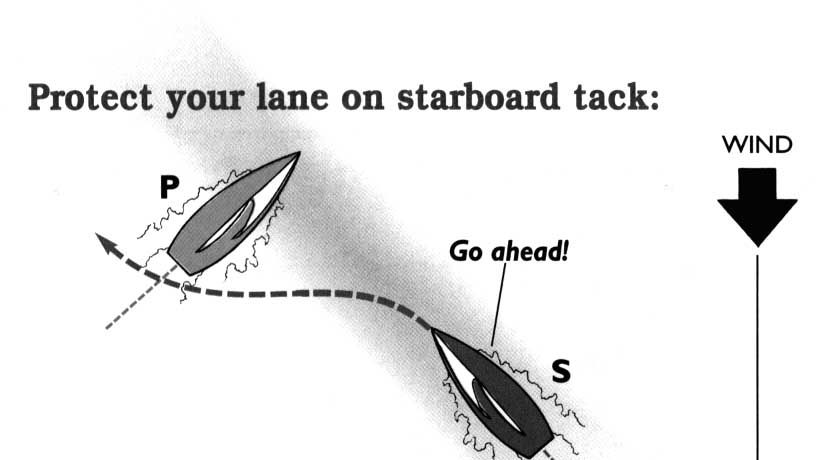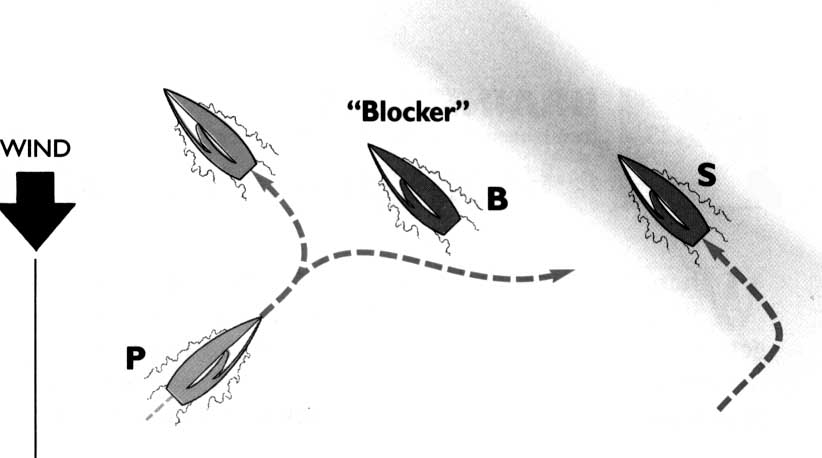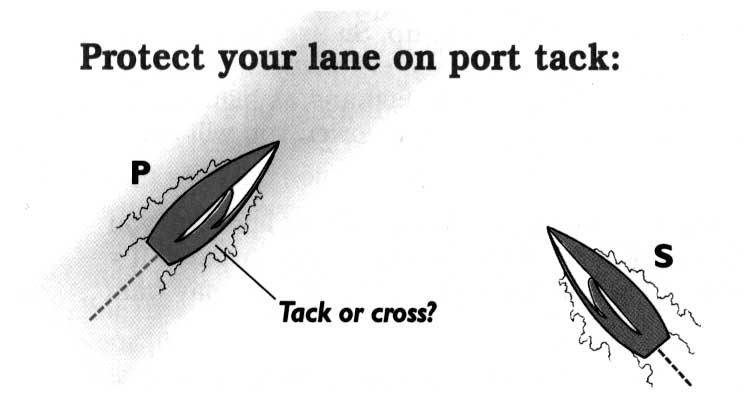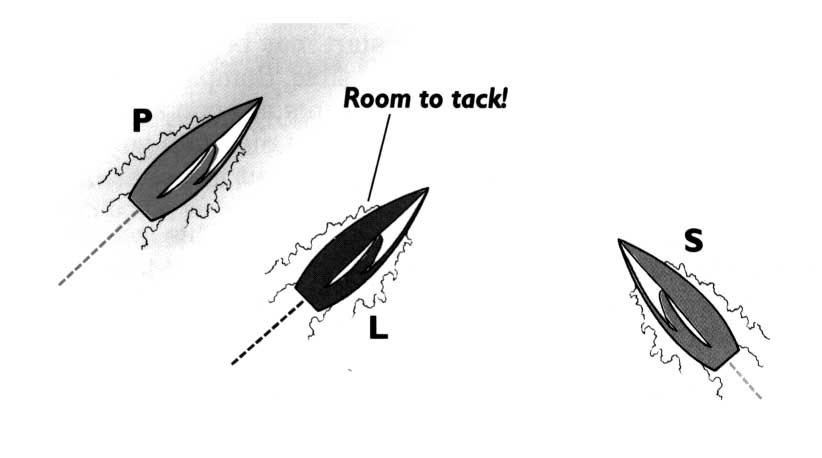
Wait a few moments for the other boats to bail out before you tack and take their sterns.
Try These Moves After Your Start
by David Dellenbaugh
During the first few minutes of any race the most important thing is to work hard at making your boat go fast. Watch the boats around you, make sure your sails are trimmed perfectly, and hike as hard as you can. Hopefully, your efforts will help you come off the line in good shape.
Whether you are in the front row or the cheap seats, however, you will undoubtedly need some sound tactics sooner or later. Tactics are the moves you make to implement your strategy in the midst of a fleet of other boats. Nowhere is this more important than right after the start, when you are always trying to fight your way through a crowd.
The reason for using tactical moves is to stay in control of your race and avoid being pushed around by your competition. Here are some moves you should consider when you come off the line.
 |
| Bail out Wait a few moments for the other boats to bail out before you tack and take their sterns. |
At any start, only a third (or perhaps half) of the boats in the fleet are in the front row with clear air. The rest end up in the second or third row, struggling to get going. Their biggest problem is that while they are sailing slowly in bad air, much of the fleet is in clear air sailing fast.
To minimize loss, the best move is usually to “bail out” (i.e. tack onto port) and search aggressively for clear air. However, tacking immediately after the start is not always the smartest idea. Sometimes when you tack right away, you have to duck behind a lot of other boats that were also in the second or third row. This may cause you to lose a lot more than if you had stayed in bad air.
If you can hang on a little longer before you tack, a lot of those boats in bad air usually tack to clear their own air (or they fall back because they are in more bad air than you). Once enough boats clear out, you can tack and sail on port without having to bear off severely behind many other boats.
To figure out the right time to tack, you (or someone on your boat) must keep a constant lookout along your ladder rung on your windward quarter. Identify the boats that will be a problem if you tack, and watch for them to bail out or fall back. Once you have an opening, go for it. Your tactics must be based on a continual assessment of whether it’s better to sail in bad air or tack and go behind other boats.
 |
| Secure a “lane” Try to match the speed and height of the boats on either side of you so you won’t get rolled or pinched off. |
One of the best things you can do at any start is come off the line with a lane of clear air. The ability to sail fast in the direction you want to go is perhaps the biggest asset of any good start. Therefore, don’t give this up easily. When you get a good lane, work hard to protect it, especially in a larger fleet or in light air where wind shadows can be devastating.
One of the best ways to keep your lane of clear air is to sail fast. By constantly working to maximize your speed, you will make it hard for other boats to get in front of you or get in your way. Of course, it’s not always easy to avoid other boats, even if your speed is good. That’s why you need a bunch of good moves to protect your “air space.”
 |
Wave port tackers across.
When you are on starboard tack, you have the right of way over port tackers, which is helpful. However, this means that converging port tackers may tack on your lee bow. If you have a good lane of clear air and you’re going the right way, the last thing you want is to have a boat tack underneath you and squeeze you off.
Therefore, don’t just shout “Starboard” to all approaching port tackers. Anticipate each crossing and think ahead about what you want. To prevent the port tacker from tacking on your lee bow, allow them to cross in front of you. There is no rule that says you can’t waive your right of way here.
To do this, bear off and clearly yell “Go ahead” or words to that effect. It’s usually better to duck behind this boat and maintain your lane of clear air than to have them lee-bow you and spend the next five minutes going slow in dirty air.
 |
Use a “blocker” to avoid incoming port tackers.
Another way to fend off converging boats is to set yourself up with a starboard-tack “blocker” on your lee bow. When you are on port tack, keep your eyes open for potential blockers. These are typically boats on starboard tack that you have to duck. They also must be in a lane of clear air themselves.
After you duck a starboard tacker, go a few boatlengths and tack onto starboard into the lane of clear air. You want to be fairly close to the blacker, but far enough that you could potentially sail for quite a while on starboard tack without falling into his bad air.
The beauty of having a blocker is that it peels off any port tackers that might tack on your lee bow. When a port tacker (P) gets to the blocker (B), P will either lee bow B (and therefore miss you) or duck B and also duck you. If you’re in the right spot, P cannot duck B and then leebow you. If P crosses ahead of B, there’s a good chance he’ll cross you too.
 |
Ask if you can cross.
The problem with trying to hold a lane of clear air when you’re on port tack is that you must keep clear of all converging starboard tackers. Obviously, if you like your lane, you wouldn’t want to avoid S by tacking. It would be much better to (think ahead and) bear off behind S so you can keep going.
Sometimes, when you are almost able to cross the starboard tacker, you can try yelling, “Tack or Cross?” Basically, you are asking the starboard tacker to let you cross in front of him. If he doesn’t let you go, you will plant a solid leebow right in front of him and gas him with your bad air.
You must communicate your intent early and clearly. If you do, S will often let you go, especially if he’s got a clear lane and/or likes going left. If he doesn’t let you cross, try to keep the option to duck behind him.
 |
Don’t have another port tacker just to leeward.
When you’re on port tack (P), it’s hard enough to hold your lane without any other port tackers around. but when you have another P close aboard to leeward (L), it’s even more difficult. Here’s why.
Let’s say you and L are sailing upwind on port tack. You’re in a great lane and your going the right way. Everything is fine until a starboard tacker (S) comes along. If L wasn’t in the picture, S wouldn’t be a problem because you can cross S. However L can’t cross S so she decides to tack. Because L can’t tack without hitting you, she hails you for room to tack under rule 19. You have to tack and lose your lane, all because L couldn’t cross S and decided to tack.
The moral of the story? Don’t put yourself in a position where another boat (L) controls your destiny.
Dave is a two-time America’s Cup veteran who publishes the newsletter Speed & Smarts. For a subscription call: 800-356-2200.